Iberian lynx
| Iberian lynx | |
|---|---|
 | |
| Scientific classification | |
| Kingdom: | Animalia |
| Phylum: | Chordata |
| Clade: | Synapsida |
| Class: | Mammalia |
| Order: | Carnivora |
| Family: | Felidae |
| Subfamily: | Felinae |
| Genus: | Lynx |
| Species: | L. pardinus |
| Binomial name | |
| Lynx pardinus (Temminck, 1827) | |
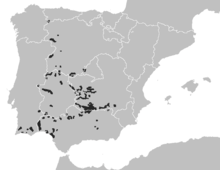 | |
| 1980 range map | |
 | |
| 2003 range map | |
The Iberian lynx (Lynx pardinus) is an endangered species of felid living mainly in the Iberian Peninsula in southwestern Europe.[2] They are categorized as endangered by many institutions, including the International Union for the Conservation of Nature.[3] The Iberian lynx is a rabbit specialist with a low ability to adapt its diet.[4][5] A sharp drop in the population of its main food source, a result of two diseases, contributed to the feline's decline. The lynx was also affected by the loss of scrubland, its main habitat, to human development, including changes in land use and the construction of roads and dams.[5][6]
According to the conservation group SOS Lynx, if the Iberian lynx died out, it would be the first feline species to become extinct since prehistoric times.[7] Captive breeding and reintroduction programs have boosted their numbers. As of 2013, Andalusia has a population of 309 living in the wild.[8][9] As an attempt to save this species from extinction, an EU LIFE Nature project is underway that includes habitat preservation, lynx population monitoring, and rabbit population management.[10]
Formerly considered a subspecies of the Eurasian lynx (Lynx lynx), the Iberian lynx is now classified as a separate species. Both species occurred together in central Europe in the Pleistocene epoch, being separated by habitat choice.[11] The Iberian lynx is believed to have evolved from Lynx issiodorensis.[12]
Description
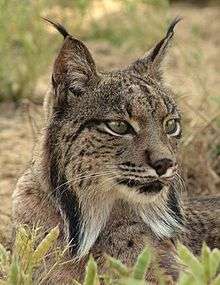
The Iberian lynx portrays many of the typical characteristics of lynxes, such as tufted ears, long legs, short tail, and a ruff of fur that resembles a "beard".[13] Unlike its Eurasian relatives, the Iberian lynx is tawny colored and spotted.[14] The coat is also noticeably shorter than in other lynxes, which are typically adapted to colder environments.[15] Some western populations were spotless but are believed to be extinct.[13] Studies have been carried out on the configuration of spots and determining the degree of genetic diversity within the species.[16]
The head and body length is 85 to 110 centimetres (33 to 43 in), with the short tail an additional 12 to 30 centimetres (4.7 to 11.8 in); the shoulder height is 60 to 70 centimetres (24 to 28 in). The male is larger than the female, with the average weight of males 12.9 kilograms (28 lb) and a maximum of 26.8 kilograms (59 lb), compared to an average of 9.4 kilograms (21 lb) for females; this is about half the size of the Eurasian lynx.[11][17][18]
The Iberian lynx is a very specialized hunter that has certain adaptations that better their ability to skillfully catch and kill small prey. They have a foreshortened skull, which maximizes the bite force of the canines. Their muzzles are narrower, they have longer jaws and smaller canines than animals that feed on larger prey.[16]
Ecology
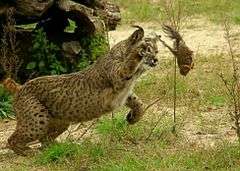
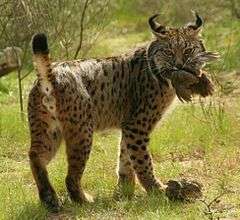
The Iberian lynx is a rabbit specialist — it prefers the European rabbit (Oryctolagus cuniculus) for the bulk of its diet (79.5–86.7%), with the remainder composed of the Granada hare (Lepus granatensis) (5.9%) and rodents (3.2%).[11] A male requires one rabbit per day while a female raising kittens will eat three per day.[19] The Iberian species has low adaptability — it continued to rely heavily on rabbits (75% of its food intake) despite the latter's repeated population crashes due to two diseases: myxomatosis, which spread to Iberia after a physician intentionally introduced it in France in 1952, and hemorrhagic disease beginning in 1988.[4][5] There were two major outbreaks of the latter in 2011 and 2012.[20] Recovery has occurred in some areas — in 2013, rabbit overpopulation was reported south of Córdoba, causing damage to transport infrastructure and farms.[21] In December 2013, however, it was reported that wildlife officials were concerned about the spread of a new strain of the hemorraghic disease, affecting mainly young rabbits.[22][23] Sierra Morena's rabbit population was worst affected, falling from an average of three per hectare to less than one — below the minimum required level of 1.5 to two per hectare.[24] Forced to travel greater distances for food, the lynx became more susceptible to death in road accidents, particularly on Autovía A-4.[24]
The Iberian lynx also hunts other mammals (including rodents and insectivores), birds (especially the red-legged partridge), reptiles and amphibians, most actively during twilight and at night.[25] It sometimes preys on young fallow deer, roe deer, mouflon, and ducks.[26] It competes for prey with the red fox, the Egyptian mongoose (Herpestes ichneumon) and the wildcat. The species is solitary and hunts alone; it will stalk its prey or lie in wait for hours behind a bush or rock until the prey is sufficiently close to pounce in a few strides.
The Iberian lynx is smaller than its northern relatives, and typically hunts smaller animals, usually no larger than hares. It also differs in habitat choice, with Iberian lynx inhabiting open scrubland and Eurasian lynx inhabiting forests.[11]
A lynx, especially with younger animals, will roam widely, with ranges reaching more than 100 kilometres (62 mi). Its territory (~ 10 to 20 square kilometres (3.9 to 7.7 sq mi)) is also dependent on how much food is available.[19] Adult Iberian lynx tend to require a minimum amount of space of 5 to 20 square kilometres (1.9 to 7.7 sq mi), and a population of 50 breeding females requires about 500 square kilometres (190 sq mi) of habitat area.[25] Nonetheless, once established, ranges tend to be stable in size over many years, the boundaries often being along man-made roads and trails. The Iberian lynx marks its territory with its urine, droppings left in existing tracks through the vegetation, and scratch marks on the barks of trees.[15]
Reproduction
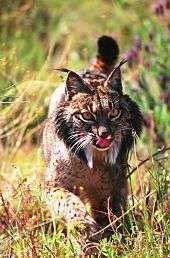
During the mating season the female leaves her territory in search of a male. The typical gestation period is about two months; the kittens are born between March and September, with a peak of births in March and April. A litter consists of two or three (rarely one, four or five) kittens weighing between 200 and 250 grams (7.1 and 8.8 oz).
The kittens become independent at 7 to 10 months old, but remain with the mother until around 20 months old. Survival of the young depends heavily on the availability of prey species. In the wild, both males and females reach sexual maturity at the age of one year, though in practice they rarely breed until a territory becomes vacant; one female was known not to breed until five years old when its mother died. The maximum longevity in the wild is 13 years.[11][18]
Siblings become violent towards one another between 30 and 60 days, peaking at 45 days. A kitten will frequently kill its littermate in a brutal fight. It is unknown why these episodes of aggression occur, though many scientists believe it is related to a change in hormones when a kitten switches from its mother's milk to meat. Others believe it is related to hierarchy, and "survival of the fittest."
Difficulty in finding mates has led to more inbreeding, which results in fewer kittens and a greater rate of non-traumatic death.[27] Inbreeding leads to lower semen quality and greater rates of infertility in males, hindering efforts to increase the species' fitness.[28]
Habitat
A study of mitochondrial DNA from fossil remains, published in March 2015, suggests the Iberian lynx had a wider range during the Late Pleistocene and Holocene, including northern Italy and southern France.[29] The species was distributed over the entire Iberian Peninsula as recently as the mid-19th century. In the 1950s it was divided between a northern population, running from Galicia and parts of northern Portugal and extending to the Mediterranean, and a southern population, in various parts of Spain.[30] It is now restricted to very limited areas of southern Spain,[31] with breeding only confirmed in two areas of Andalucía. The Iberian lynx prefers heterogeneous environments of open grassland mixed with dense shrubs such as strawberry tree, mastic, and juniper, and trees such as holm oak and cork oak. It is now largely restricted to mountainous areas.
Conservation
The Iberian lynx has recently gone from the critically endangered species;[1] to the endangered species;[1] thanks to reintroduction and other conservation actions.[32] If the Iberian lynx were to become extinct, it would be the first big cat species to do so since Smilodon populator 10,000 years ago. Its small population makes the cat especially vulnerable to extinction from sudden random events such as a natural disaster or disease.[33] Conservation measures include restoring its native habitat, maintaining the wild rabbit population, reducing unnatural causes of death, and captive breeding for release.[33] The Spanish National Commission for the Protection of Nature endorsed the Iberian Lynx Ex Situ Conservation Breeding Program to serve as a "safety net" by managing the captive population and also to "help establish new Iberian lynx free-ranging populations through reintroduction programmes."[33] Before release of captive-bred cats, their natural habit may be simulated to prepare them for life in the wild.[33] A 2006 study used a non-intrusive monitoring system involving cameras to monitor the demographics of both lynxes and rabbits residing in Sierra Morena.[34] Supplemental food sources could be provided if wild rabbits suffered a decline.[34]
The Iberian lynx and its habitat are fully protected, and they are no longer legally hunted. Threats include habitat loss, vehicle strikes, poisoning, feral dogs, illegal poaching, and occasional outbreaks of feline leukemia.[35] Chronic renal illness affects some captive animals.[36] Habitat loss is due mainly to infrastructure improvement, urban and resort development and tree monocultivation, which fragments the lynx's distribution. In the 20th century, rabbit diseases such as myxomatosis and hemorrhagic disease resulted in a dramatic decline of its main prey;[37] outbreaks have been reported into the 2010s.[20] Accidental vehicle strikes are the leading cause of unnatural death;[38][39] The death toll on Spanish roads was 14 in 2013,[40] and 21 in 2014.[41] Illegal traps set for rabbits and foxes are other leading causes for lynx fatality.[42]
In 2013, it was reported that the Iberian lynx possesses antibiotic resistant bacteria within its digestive tract, which may lead to more dangerous and difficult-to-treat infections and decrease the cat's fitness.[43] A 2013 study suggests climate change may threaten the Iberian lynx species due to their inability to adapt well to new climates or it may lead them to relocate to areas that have a more suitable climate but fewer rabbits, increasing mortality.[44]
Management efforts are being developed to conserve and restore the animal's native range.[2] Officials intending to release captive-bred lynx look for areas of appropriate habitat, rabbit abundance, and acceptance by the local human population.[45] About 90 million euros was spent on various conservation measures between 1994 and 2013.[46] The European Union contributes up to 61% of funding.[22][35]
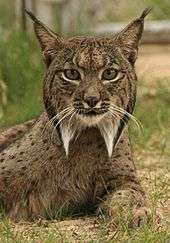
Wild population and re-introductions

The Iberian lynx species has declined by about 80% in the last 20 years. The cat was estimated to number 3,000 in 1960,[47] about 400 in 2000, less than 200 in 2002, and possibly as few as 100 in March 2005.[48] Doñana National Park and the Sierra de Andújar, Jaén had the only known breeding populations until the 2007 discovery of a previously unknown population of around 15 individuals in Castile-La Mancha (central Spain).[49][50] In 2008, the Doñana population was assessed at 24 to 33, while the Sierra Morena group was believed to number 67 to 190 adults. The total population was estimated to be 99 to 158 adults, including the La Mancha population. The Iberian lynx was thus listed as Critically Endangered under C2a(i) on the IUCN Redlist.[1]
Beginning in 2009, the Iberian lynx was reintroduced into Guadalmellato, resulting in a population of 23 in 2013.[9] Since 2010, the species has also been released in Guarrizas.[45][51] Discussions were held with the Ministry of Environment on plans for releases in the Campanarios de Azaba area near Salamanca.[52] In April 2013, it was reported that Andalusia's total wild population—only 94 in 2002—had tripled to 309 individuals.[8][9] In July 2013, environmental groups confirmed the presence of a wild-born litter in the Province of Cáceres (Extremadura).[53] A study published in July 2013 in Nature Climate Change advised that reintroduction programs take place in northern Iberia, suggesting that climate change would threaten rabbits in the south.[46][54]
On November 26, 2014, 8 Iberian lynxes were released into Toledo, Spain, one of them traveled near Madrid, the first time in 40 years.[55]
The presence of Iberian lynxes in Portugal (particularly in the south) has been verified,[56] but there is no evidence of reproduction. In 2014, the Institute for Nature Conservation and Forests signed contracts securing 2,000 hectares of land for Portugal's reintroduction project.[57] On December 16, 2014, a pair of Iberian lynx was released into Guadiana Valley Natural Park near Mértola, Portugal.[58] On February 7, 2015, another pair was released into the park, but the female was later found dead on March 12, 2015 after being poisoned in Mertola.[59] The last pair of captive-bred Iberian lynxes were released into Guadiana Valley Nature Reserve on May 12, 2015.[60] By the end of 2015 there were 400 lynx on the Iberian peninsula, the vast majority in Andalusia, in southern Spain, but with smaller new populations in the hills near Toledo, in Extremadura (south-western Spain) and in southern Portugal.[61]
Since a 2007 outbreak of feline leukemia virus (FeLV), wild lynxes are tested periodically for possible disease. September–December 2013 samples were negative for FeLV but one male became the first of his species to test positive for feline immunodeficiency virus (FIV) and was placed into quarantine.[62]
Captive breeding
In 2002, the Jerez Zoo confirmed it had three females and was developing a plan for a captive breeding program.[7] One of those females was Saliega, captured as a kitten in April 2002.[7] She became the first Iberian lynx to breed in captivity, giving birth to three healthy kittens on 29 March 2005 at the El Acebuche Breeding Center, in the Doñana Nature Park in Huelva, Spain.[63] Over the following years, the number of births grew and additional breeding centers were opened. In March 2009, it was reported that 27 kittens had been born since the beginning of the program.[64] In 2009, the Spanish government planned to build a €5.5 million breeding center in Zarza de Granadilla.[64] Portugal established a breeding center in Silves.[65][66]
There were 14 surviving kittens in 2008 and 15 in 2009.[67] In 2010, intense rain and health issues resulted in lower reproductive success—14 born, 8 surviving[67]—but the next year, breeding centers recorded 45 births with 26 surviving kittens.[68] In 2012, breeding centers in Portugal and Spain reported a total of 44 survivors from 59 births,[68][69] while 2013 saw a total of 44 survivors out of 53 born.[70]
In March 2013, it was reported that Iberian lynx embryos and oocytes had been collected and preserved for the first time.[71] They were collected from Saliega and another female—both sterilized and retired from the breeding program—by Berlin's Leibniz Institute for Zoo and Wildlife Research and stored in liquid nitrogen at the Museo Nacional de Ciencias Naturales de Madrid for possible future breeding.[71] In July 2014, the MNCN-CSIC announced they had produced sperm cells from the testicular tissue of sexually immature lynx.[72]
Iberian lynx can be observed in captivity only at the Jerez Zoo[73] and, since December 2014, at the Lisbon Zoo.[74] The Jerez animals integrate the breeding program, while the two Lisbon lynxes were formerly in the Portuguese breeding center but are no longer suited for the program (the female had multiple failed pregnancies and the male has a form of epilepsy).[75]
Genetic studies
In August 2012, researchers announced that the genome of the Iberian lynx had been sequenced.[76] They also plan genetic testing of the remains of long-deceased lynx to quantify loss of genetic diversity and improve conservation programs.[77] In December 2012, it was reported that researchers had located remains of 466 Iberian lynx in private and museum collections.[77] However, it is estimated that 40% of specimens were lost over the preceding 20 years.[77]
Genetic diversity in the Iberian lynx is lower than in any other felids known to be genetically impoverished, including the cheetah (Acinonyx jubatus), Ngorongoro crater lions, and Scandinavia's Eurasian lynx. Researchers believe this may be a consequence of decreasing population sizes and isolation.[78] A study published in 2013 indicated strong genetic differentiation between the Doñana and Andujar populations, due to both allelic frequencies and allelic composition. Doñana lynxes have differentiated more from the ancestral population as a result of their longer isolation and lower population size.[78] The researchers suggested bringing the two groups together in order to lessen the degree of inbreeding.[78]
See also
References
- 1 2 3 4 Rodríguez, A. & Calzada, J. (2014). "Lynx pardinus". IUCN Red List of Threatened Species. Version 3.1 (3.1). International Union for Conservation of Nature. Retrieved 24 June 2015.
- 1 2 Clavero, Miguel; Delibes, Miguel (2013). "Using historical accounts to set conservation baselines: the case of Lynx species in Spain". Biodiversity Conservation Journal. 22: 1691–1702. doi:10.1007/s10531-013-0506-4.
- ↑ Gil-Sanchez, J. M.; McCain, E. B. (2011). "Former range and decline of the Iberian lynx (lynx pardinus) reconstructed using verified records". Journal of Mammalogy. 92 (5): 1081–1090. doi:10.1644/10-MAMM-A-381.1.
- 1 2 "Iberian Lynx Depends On Rabbits for Survival". Science Daily. 5 July 2011.
- 1 2 3 Platt, John R. (12 July 2011). "Deadly Rabbit Disease May Have Doomed Iberian Lynx". Scientific American.
- ↑ Alda, F.; Inogés, J.; Alcaraz, L.; Oria, J.; Aranda, A.; Doadrio, I. (2008). "Looking for the Iberian lynx in central Spain: a needle in a hay stack?". Animal Conservation. 11 (4): 297–305. doi:10.1111/j.1469-1795.2008.00185.x. ISSN 1367-9430.
- 1 2 3 Gonçalves, Eduardo (April 2002). "Captured cubs hold future of Europe's tiger". London: The Guardian. Retrieved July 2011. Check date values in:
|access-date=(help) - 1 2 "La población de linces se triplica en Andalucía en los últimos diez años" [The lynx population has tripled in Andalusia in the last ten years]. El Mundo (in Spanish). 9 April 2013.
- 1 2 3 "La Junta de Andalucía refuerza en el Guadalmellato la población de lince ibérico con la suelta de dos ejemplares" [Andalusia reinforces Iberian lynx population in Guadalmellato with the release of two individuals]. El Economista (in Spanish). 8 April 2013.
- ↑ Alcaide, M.; et al. (2012). "Gene sets for utilization of Primary and Secondary Nutrition supplies in the Distal gut of Endangered Iberian Lynx". PLOS ONE. 3 (12): e51521. doi:10.1371/journal.pone.0051521.
- 1 2 3 4 5 "Iberian lynx Lynx pardinus". IUCN Cat Specialist Group.
- ↑ Kurtén, Björn (1968). Pleistocene Mammals of Europe. Transaction Publishers.
- 1 2 Lynx (n.d.): 1-2., EBSCOhost
- ↑ "Iberian lynx". WWF. Retrieved 24 October 2013.
- 1 2 Sunquist, Mel; Sunquist, Fiona (2002). Wild cats of the World. Chicago: University of Chicago Press. pp. 177–184. ISBN 0-226-77999-8.
- 1 2 "Lynx pardinus — Details". Encyclopedia of Life. Retrieved 24 October 2013.
- ↑ "Iberian lynx Lynx pardinus". United Nations Environment Programme World Conservation Monitoring Centre.
- 1 2 "Lynx pardinus". Animal Diversity Web.
- 1 2 Ward, Dan (2004). "The Iberian Lynx Emergency" (PDF). Archived from the original (PDF) on September 27, 2007. Retrieved 2007-05-13.
- 1 2 "La población de lince en Andalucía es de 305 ejemplares, 7 menos que en 2011" [Lynx population in Andalucia is 305, 7 less than in 2011]. EFE (in Spanish). Terra.es. 17 September 2013.
- ↑ Madueno, J. J. (5 August 2013). "La Junta gasta 500.000 euros en conejos para el lince y no ataja las plagas en el sur" [500,000 euros wasted on rabbits for the lynx despite rabbit overpopulation in south] (in Spanish). ABC.es.
- 1 2 Viúdez, Juana (15 December 2013). "Iberian lynx faces new threat as disease decimates rabbit population". El Pais.
- ↑ "A new variant of the rabbit hemorrhagic disease endangers the Iberian lynx". phys.org. 11 February 2015.
- 1 2 Poveda, J. E. (14 May 2014). "El lince vuelve a estar en máximo riesgo" [The lynx again at maximum risk level]. ideal.es (in Spanish).
- 1 2 Lopez-Bao, JV; et al. (2011). "Intraspecific interference influences the use of prey hotspots". OIKOS. 120 (10): 1489–1496. doi:10.1111/j.1600-0706.2011.19194.x.
- ↑ Delibes, Miguel; Rodríguez, Alejandro; Ferreras, Pablo (1 January 2000). Action Plan for the Conservation of the Iberian Lynx in Europe (Lynx Pardinus). Council of Europe. p. 17. ISBN 978-92-871-4423-2.
- ↑ Palomares, Francisco; Godoy, Jose Antonio; Lopez-Bao, Jose Vicente (2012). "Possible Extinction Vortex for a Population of Iberian Lynx on the Verge of Extirpation". European Journal of Wildlife Research. 58 (5): 881–84.
- ↑ Jose Ruiz-Lopez, Maria; Ganan, Natalia; Godoy, Jose Antonio (2013). "Heterozygosity-Fitness Correlations and Inbreeding Depression in Two Critically Endangered Mammals". Conservation Biology. 148 (1): 55.
- ↑ Rodríguez-Varela, Ricardo; Tagliacozzo, Antonio; Ureña, Irene; García, Nuria; Crégut-Bonnoure, Evelyne; Mannino, Marcello A.; Arsuaga, Juan Luis; Valdiosera, Cristina (15 March 2015). "Ancient DNA evidence of Iberian lynx palaeoendemism". Quaternary Science Reviews. 112: 172–180. Bibcode:2015QSRv..112..172R. doi:10.1016/j.quascirev.2015.01.009.
- ↑ Biodiversity and Conservation
- ↑ Hogan, C. Michael (2011). "Alboran Sea". In P. Saundry; C.J. Cleveland. Encyclopedia of Earth. Washington DC: National Council for Science and the Environment.
- ↑ http://www.iucnredlist.org/details/12520/0
- 1 2 3 4 Vargas, A.; et al. (2008). "The Iberian lynx Lynx pardinus Conservation Breeding Program". International Zoo Yearbook. 42: 190–198. doi:10.1111/j.1748-1090.2007.00036.x.
- 1 2 Gil-Sánchez, J.; Simón, M.; Cadenas, R.; Bueno, J.; Moral, M.; Rodríguez-Siles, J. (2010). "Current Status Of the Iberian Lynx (Lynx pardinus) In eastern Sierra Morena, Southern Spain". Wildlife Biology in Practice. 6 (3): 14–33. doi:10.2461/wbp.lynx.2.
- 1 2 "El lince ibérico inicia una incierta <<reconquista>>" [The Iberian lynx begins an uncertain "reconquest"]. EFE (in Spanish). ABC.es. 3 October 2009.
- ↑ Sierra, David (26 March 2010). "Expertos temen por la muerte de linces" [Experts fear lynx deaths] (in Spanish). rtve.es.
- ↑ http://wwwnc.cdc.gov/eid/article/20/12/14-0517_article
- ↑ Sala, Javier (5 December 2013). "El número de linces ibéricos atropellados se dispara por culpa de cuatro carreteras". Materia Ciencia (in Spanish).
- ↑ "WWF insta a prevenir atropellos de linces en la Autovía Madrid-Sevilla" [WWF urges action to prevent lynx casualties on the Madrid-Sevilla highway] (in Spanish). Europa Press. 11 September 2013.
- ↑ "El atropello mortal de 14 linces en 2013 merma la recuperación de la especie" [14 lynxes were fatally run over in 2013, undermining the species' recovery]. EFE (in Spanish). Andaluces Diario. 1 January 2014. Archived from the original on 6 January 2014.
- ↑ Donaire, Ginés (19 February 2015). "Rise in Iberian lynx road deaths speeds up protection plans". El País.
- ↑ Ferreras, P.; Aldama, J.J.; Beltran, J.; Delibes, M. (1992). "Rates and causes of mortality in a fragmented population of Iberian lynx Felis pardina Temminck, 1824". Biological Conservation. 62 (3): 197–202. doi:10.1016/0006-3207(92)91116-a.
- ↑ Gonçalves, Alexandre; Igrejas, Gilberto; Hajer, Tiago (2013). "Detection of Antibiotic Resistant Enterococci and Escherichia coli in Free Range Iberian Lynx (Lynx pardinus)". Science of the Total Environment. 456-457: 115–9. doi:10.1016/j.scitotenv.2013.03.073. PMID 23588135.
- ↑ Fordham, D. A.; Akçakaya, H. R.; Brook, B. W.; Rodríguez, A.; Alves, P. C.; Civantos, E.; Triviño, M.; Watts, M. J.; Araújo, M. B. (2013). "Adapted conservation measures are required to save the Iberian lynx in a changing climate". Nature Climate Change. 3 (10): 899–903. Bibcode:2013NatCC...3..899F. doi:10.1038/nclimate1954.
- 1 2 Alves, Filipa (21 June 2013). "Lince-ibérico: Jazz e Joaninha, que nasceram em Silves em 2012, foram hoje libertados na Andaluzia" [Iberian lynx: Jazz and Joaninha, who were born in Silves in 2012, were released today in Andalusia]. Naturlink (in Portuguese).
- 1 2 "Iberian lynx threatened by climate change". The University of Adelaide. 22 July 2013.
- ↑ "SOSLynx.org". Retrieved July 2011. Check date values in:
|access-date=(help) - ↑ "Iberian lynx in 'gravest danger'". BBC News. 10 March 2005. Retrieved 10 April 2007.
- ↑ "New Population Of Iberian Lynx Raises Hope For Species' Survival". Science News. October 2007. Retrieved July 2011. Check date values in:
|access-date=(help) - ↑ Ward, Dan (April 2008). "Lynx presence in Castilla-La Mancha" (PDF). LynxBrief. 10: 3.
- ↑ Ward, Dan (December 2008). "LynxBrief" (PDF). Retrieved July 2011. Check date values in:
|access-date=(help) - ↑ "Wildlife returns to Western Iberia". Rewilding Europe. 2012-05-08.
- ↑ "Grupos ecologistas confirman que el lince ibérico cría en libertad en Cáceres" [Environmental group confirm the Iberian lynx is breeding in the wild in Cáceres]. EFE (in Spanish). ABC.es. 6 July 2013.
- ↑ Ghose, Tia (21 July 2013). "Climate Change Could Wipe Out Iberian Lynx". Live Science.
- ↑ "Iberian Lynx returns to Madrid region after 40 years". March 10, 2015.
- ↑ Soares, Marisa (1 June 2013). "Lince ibérico, o mais ameaçado dos felinos, fotografado em Milfontes" [The Iberian Lynx, the most threatened feline, was photographed in Milfontes]. Publico.pt (in Portuguese).
- ↑ Bratley, Carrie-Marie (13 November 2014). "More space in Portugal in pipeline for Iberian Lynx". The Portugal News.
- ↑ "Portugal makes history with first release of Iberian Lynx". The Portugal News. 18 December 2014.
- ↑ "Iberian Lynx female released last month found dead". March 19, 2015. Retrieved March 24, 2015.
- ↑ "Final two Iberian Lynx released into the wild". theportugalnews.com. The Portugal News. May 14, 2015. Retrieved June 7, 2015.
- ↑ "The return of the lynx". bbc.com. BBC. March 28, 2016. Retrieved April 12, 2016.
- ↑ "Resultado negativo en los chequeos a linces para detectar leucemia felina, con un positivo de virus de inmunodeficiencia" [Lynxes negative for feline leukemia but one positive for immunodeficiency virus]. Europa Press (in Spanish). La Informacion. 30 December 2013. Archived from the original on 31 December 2013.
- ↑ "Hopes raised by Spain lynx births". BBC News. 30 March 2005. Retrieved 5 September 2012.
- 1 2 "Endangered Iberian lynx cubs born in Spain". Associated Press. 20 March 2009. Retrieved July 2011. Check date values in:
|access-date=(help) - ↑ Bratley, Carrie-Marie (27 June 2013). "Silves-born Iberian lynx released in Spain". The Portugal News.
- ↑ Tomás, Carla; de Atayde, André (2 April 2013). "Quinze crias de lince ibérico nascem em Silves" [Fifteen Iberian lynx cubs born in Silves]. Expresso.sapo.pt (in Portuguese).
- 1 2 Sierra, David (18 August 2010). "Fallece 'Geo', uno de los cachorros de lince ibérico nacido en cautividad este año" [Death of 'Geo', one of this season's captive-born Iberian lynx cubs] (in Spanish). rtve.es.
- 1 2 "Nacen 59 ejemplares de lince esta temporada en el Programa de Cría en Cautividad" [59 lynx kittens born this season as part of the Captive Breeding Program]. Europa Press (in Spanish). 17 June 2012. Retrieved 13 July 2012.
- ↑ "Success in Silves as seven lynx cubs are born". The Portugal News. 31 March 2012. Retrieved 13 July 2012.
- ↑ "El programa de cría en cautividad del lince ibérico acaba la temporada con 44 cachorros" [The lynx captive breeding program ends the season with 44 cubs]. EFE (in Spanish). 20minutos.es. 9 September 2013.
- 1 2 "For the first time Iberian lynx embryos are collected and preserved". Forschungsverbund Berlin e.V. (FVB). phys.org. 23 March 2013.
- ↑ Mosquera Rodriguez, Eva (22 July 2014). "Esperma 'de laboratorio' para salvar al lince ibérico" [Laboratory-made sperm to save the Iberian lynx]. El Mundo (in Spanish).
- ↑ "The Iberian Lynx at the Zoobotanico de Jerez (in Spanish)".
- ↑ Novais, Vera (21 December 2014). "Os felinos mais ameacados do mundo ja moram em Lisboa" [O casal de linces-ibéricos chegou ao Jardim Zoológico de Lisboa com uma missão especial: mostrar aos visitantes o que os torna os felinos mais ameaçados do mundo.]. Observador (in Portuguese).
- ↑ Figueiredo, Filipe (17 March 2015). "Nova Visita ao Zoo de Lisboa – O Lince Ibérico" [New visit to the Lisbon Zoo – The Iberian Lynx]. O Último Reduto (in Portuguese).
- ↑ Ansede, Manuel (8 August 2012). "Secuenciado el genoma del lince ibérico" [Genome of the Iberian lynx is sequenced]. Materia (in Spanish).
- 1 2 3 Ansede, Manuel (31 December 2012). "Hay más linces ibéricos disecados o convertidos en alfombras que vivos" [There are more Iberian lynx stuffed or converted into carpets than living ones]. Materia (in Spanish).
- 1 2 3 Casas-Marce, M.; Soriano, L.; López-Bao, J. V. & Godoy, J. A. (2013). "Genetics at the verge of extinction: insights from the Iberian lynx". Molecular Ecology. 22 (22): 5503–5515. doi:10.1111/mec.12498.
External links
| Wikimedia Commons has media related to Lynx pardinus. |
| Wikispecies has information related to: Lynx pardinus |
- Large Carnivore Initiative for Europe – Iberian lynx
- Programa de Conservación Ex-Situ Official Spanish government page (Spanish)
- Species portrait Iberian lynx; IUCN/SSC Cat Specialist Group
- ARKive – Images and movies of the Iberian lynx (Lynx pardinus)
- The natural history of the Iberian lynx
- Lynx in vertebradosibericos.org (Spanish)
- WWF species profile: Iberian lynx
- Lynx pardinus in Naturdata (Portuguese)
